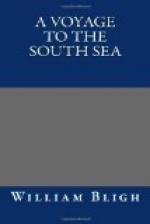Wild pigeons, parrots, and other birds were about the summit of the island but, having no firearms, relief of that kind was not to be expected unless we should find some unfrequented spot where the birds were so tame that we might take them with our hands.
The shore of this island is very rocky except the place at which we landed, and here I picked up many pieces of pumice-stone. On the part of the main nearest to us were several sandy bays which at low water became an extensive rocky flat. The country had rather a barren appearance except in a few places where it was covered with wood. A remarkable range of rocks lay a few miles to the south-west, and a high peaked hill seemed to terminate the coast towards the sea, with islands to the southward. A high fair cape showed the direction of the coast to the north-west about seven leagues distant; and two small isles lay three or four leagues to the northward of our present station.
I saw a few bees or wasps and several lizards; and the blackberry bushes were full of ants nests, webbed like a spider’s but so close and compact as not to admit the rain. A trunk of a tree about 50 feet long lay on the beach, from which I conclude that a heavy sea sets in here with a northerly wind.
This day being the anniversary of the restoration of King Charles the Second, and the name not being inapplicable to our present situation (for we were restored to fresh life and strength) I named this Restoration Island; for I thought it probable that Captain Cook might not have taken notice of it. The other names which I have presumed to give the different parts of the coast are meant only to show my route more distinctly.
At noon I observed the latitude of the island to be 12 degrees 39 minutes south, our course having been north 66 degrees west, distance 18 miles from yesterday noon. The wind was at east-south-east with very fine weather.




